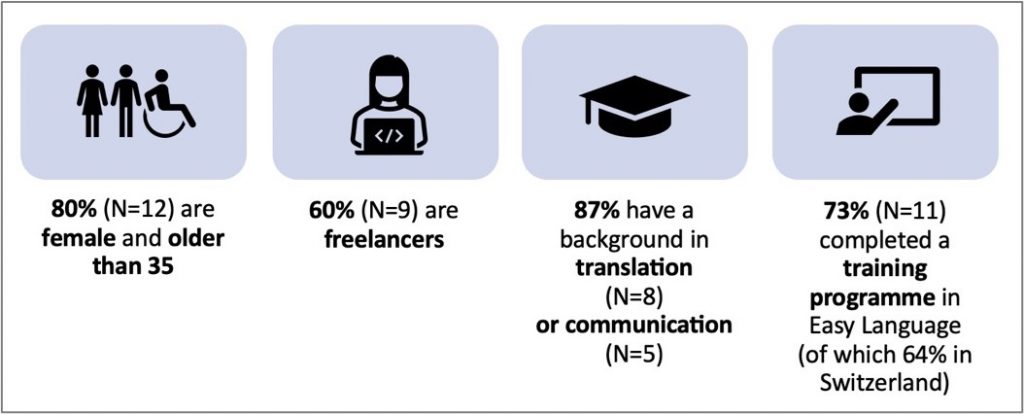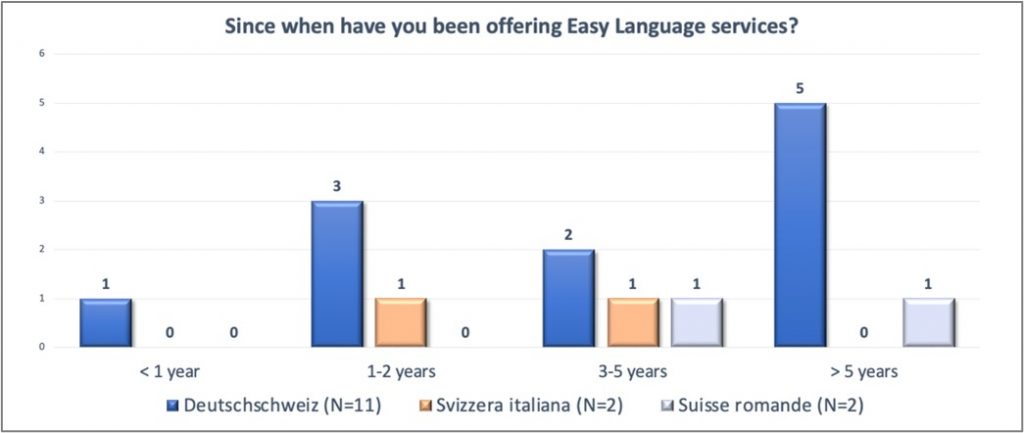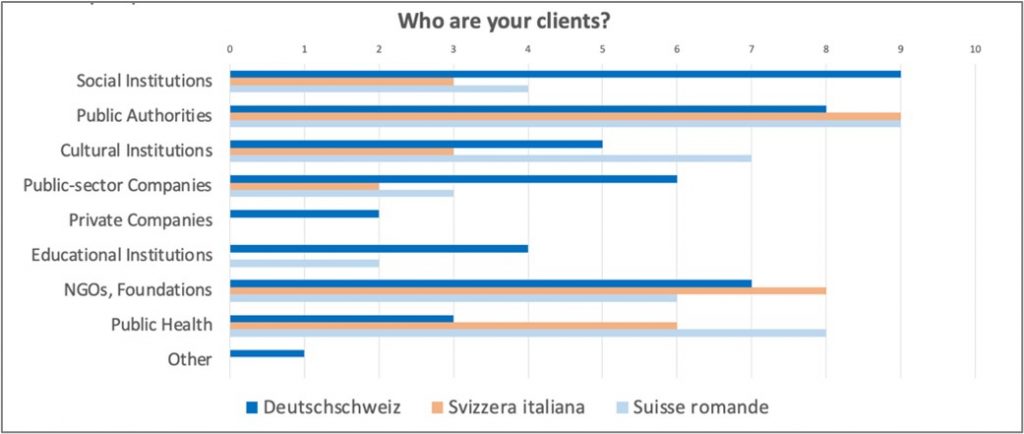Female, 35 or older, and over three years in business. This is the typical profile of an Easy Language service provider in Switzerland, as emerged in our 2021 survey of Swiss-based Easy Language practitioners. In this blog post, we discuss the results of this survey, which we first presented at KLAARA 2021. They offer valuable insights into the current issues in Easy Language service provision in Switzerland and highlight interesting differences across the country’s language regions.
Survey: Motivation and timeframe
Since Switzerland ratified the UN Convention on the Rights of Persons with Disabilities in 2014, the number of translation agencies and training programmes focusing on Easy Language has steadily increased. Against this background, in 2020 we conducted the first online survey among Easy Language practitioners in Switzerland. The aim of the survey was to gain preliminary information on Easy Language service provision Swiss-wide (cf. Parpan-Blaser et al. 2021: 589–90). In 2021, we replicated the study to validate our findings and obtain a longitudinal perspective of providers’ behaviours and perceptions. Our 2021 survey consisted of 25 items and 21 closed-ended questions, as well as four open-ended questions to collect qualitative data. The survey was available in German, French and Italian and was distributed to a pool of 19 Swiss-based service providers, whom we selected through purposive sampling. The survey was self-administered via a commercial online survey tool and all the data were collected anonymously.
Respondents’ profile: Who does the work?
The survey response rate was highly satisfactory. Fifteen participants responded: 11 from the German-speaking regions and two each from the Italian- and French-speaking regions.

Figure 1. Demographic profile of respondents (N=15)
Most of the respondents were female freelancers aged 35 and over with an educational background in translation or education, who had previously completed a subject-specific training programme in Switzerland (see Figure 1).
Time of service: Some regional differences
At time of the survey, a large majority of the respondents (66%) had been offering Easy Language services for more than three years.

Figure 2. Respondents’ time of service
Five of the 11 respondents from German-speaking Switzerland had been active in the field for more than five years, whereas 50% of the Swiss Italian respondents had only entered the field in the previous two years (see Figure 2). These data seem to mirror the pace at which Easy Language initiatives have been progressing in Germany and Austria, and in France and Italy, respectively.
Type of service: Intralingual vs interlingual translations
Our survey indicated that translations from Standard into Easy Language were the most common in 2021. However, although not many of the Swiss German respondents provided interlingual translations, for example, from Lingua facile to Leichte Sprache , the situation was quite different in the French- and Italian-speaking regions.

Figure 3. Respondents’ type of service [where 0 = never and 10 = most frequently]
Particularly in the latter, interlingual translation was the most common service, suggesting that texts are first drafted in Easy German and later translated into Easy Italian or Easy French. This raises the question as to whether interlingual translations of Easy Language texts are functionally appropriate for the target readers’ own linguistic and cultural settings (cf. Parpan-Blaser et al. 2021: 589).
Workload and order volume: Easy Language as a subsidiary professional activity
At the time of the survey, 67% of the respondents devoted less than 50% of their overall workload to Easy Language provision, with 7 out of 15 devoting less than 25% (see left chart in Figure 4). It is interesting that both Swiss-Italian respondents in our sample fell under the latter subgroup.

Figure 4. Respondents’ workload and order volume
Our demographics revealed a sample population aged 35 and older. We may assume that our respondents had an already well-established career path and that Easy Language provision only accounted for a subsidiary part of their workload profile. In addition, 11 participants reported that their order volume at the time was moderate to very low (see chart on the right in Figure 4). Interestingly, our 2020 survey revealed a higher percentage of respondents describing their order volume as low or very low (35%) and, on the other end of the scale, a lower percentage of high to very high responses (18% compared to 25% in 2021). This means that order volume increased in the first half of 2021. In fact, 10 out of 15 the respondents (67%) to our second survey stated that the pandemic had had a moderate to very high impact on their workload, which had generally increased.
Client base: Social institutions and public authorities
Overall, our survey data indicated that social institutions and public authorities were the main stakeholders for Easy Language services in 2021 (see Figure 5). Not surprisingly, the global pandemic had caused demand from public health partners to increase considerably since 2020, particularly in the French- and Italian-speaking regions.

Figure 5. Respondents’ client base [where 0 = never and 10 = most frequently]
It should also be noted that, at the time of the survey, the Swiss-German respondents (marked in dark blue in Figure 5) mostly worked for social institutions, such as residential homes. This may suggest that community organisations in German-speaking Switzerland have promoted Easy Language more actively than similar institutions elsewhere in the country. Further research is needed to confirm these data.
Professional status: Societal acknowledgement is yet to be achieved
When asked to express their opinion on whether Easy Language translation was being acknowledged as a professional activity based on specialised skills, 11 out of 19 respondents (73%) stated that writing in and/or translating into Easy Language was not yet fully acknowledged as a specialised profession (moderately to not at all). At the same time, however, 12 out of 19 respondents (80%) reported that public awareness of the key functions of Easy Language was growing in Switzerland (moderately to totally).
Growing awareness of and interest in the benefits of Easy Language
The survey results revealed that the number of Easy Language service providers is growing in all the language regions of Switzerland, but that the type of service, the provider workload, and the client base vary from one region to the other. Our data also suggests that the awareness of and interest in the benefits of Easy Language for the target population are increasing in the country. This might soon trigger a stronger interplay between practice and research, as well as a more professional exchange among providers Swiss-wide. In addition, as our survey indicated, interlingual translation is one of the most common services – if not the most common – in Italian- and French-speaking Switzerland. We can expect this practice to continue to gain momentum in Switzerland’s multilingual context, and more specifically, in bilingual cantons. Among the open questions that future research could address are: how do intra and interlingual translational processes differ, and in what manner – and to what extent – can source and target texts in interlingual translation (e.g. Leichte Sprache to Lingua facile) positively or negatively influence each other?
Luisa Carrer is a Research Associate in Accessible Communication at the Institute of Translation and Interpreting of the ZHAW Zurich University of Applied Sciences, Switzerland.
Andrea Sterchi is a journalist and writing coach. She has worked as a freelance translator and copywriter in Easy and Plain Language since 2015. In 2020, she co-funded infoeasy, the first Swiss online news magazine in Easy Language.
Further information
Parpan-Blaser, A., Girard-Groeber, S., Antener, G. et al. (2021). Easy Language in Switzerland. In C. Lindholm & U. Vanhatalo (Eds.), Handbook of Easy Languages in Europe (Easy – Plain – Accessible, Vol. 8, pp. 573–622). Berlin: Frank & Timme.
